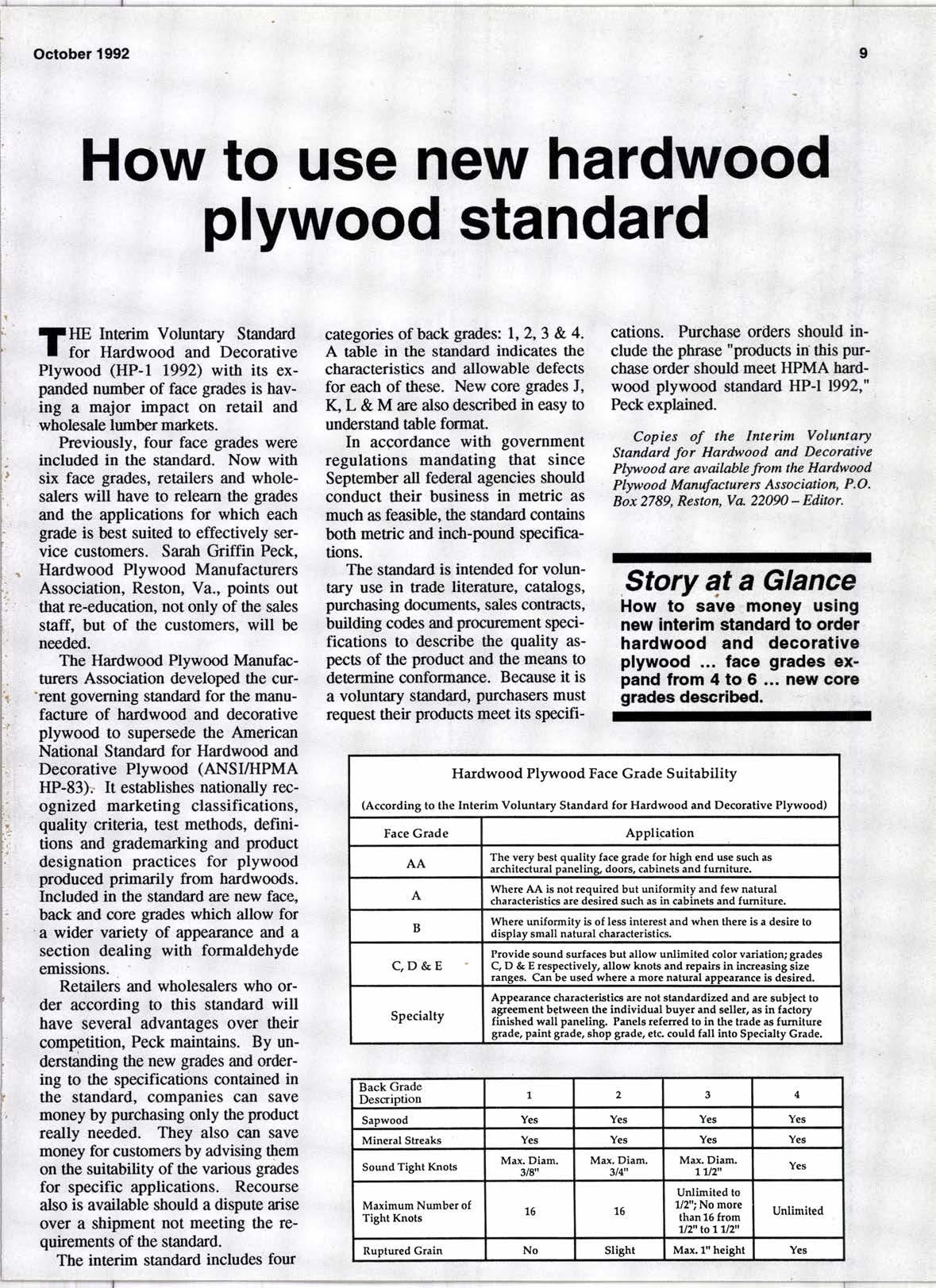
2 minute read
How to use new hardwood plywood standard
TIIE Interim Voluntry Standtrd I for Hardwood and Decorative Plywood (HP-l 1992) with its expuded number of face grades is having a major impact on retail and wholesab lunber markets.
Prcviously, four face grades were included in the standard. Now with six face grades, retailers and wholesalers will have to nelearn the grades and the applications for which each grade is best suited to effectively service customers. Sarah Griffin Peck, Hardwood Plywood Manufacturers Association, Reston, Va., points out that re-education, not only of the sales staff, but of the customers, will be needed.
The Hardwood Plywood Manufacturers Association developed the cur-rcnt governing standard for the rnanufacture of hardwood and decorative plywood to supersede tbe American National Standard for Hardwood and Decorative Plywood (ANSIAIPMA HP-83), It establishes nationally recognized marketing classifications, quality critena test methods, definitions and grademarking and product designation practices for plywood produccd primarily ftom hardwoods. Included in the standard are new face' bac,k and core grades which allow for a wider variety of appearance and a .e".tiol dealing with fonnaldehyde elussrons.
Retailers and wholesalers who order according to this standard will have several advantages over their competition, Peck maintains. By understanding the new grades and ordering to the specifications coniained in the standar4 companies can save money by purchasing orly the product really needed. They also can save money for customers by advising them on the suitability of the various grades for specific applications. Recourse also is available should a dispute arise over a shipment not meeting the requirements of the sundard.
The interim standard includes four categories of brck grades: 1,2,3 & 4. A table in the standard indicates the characteristics and allowable defects for each of these. New core grades J, K L & M are alsodescribed in easy to understand table fqmat.
In accordance with govefnment regulations mandating that since September all federal agencies should conduct their business in metric as much as feasible, the smndard oonains both meuic and inctr-pound specifications.
The standard is intded for voluntaf,y use in trade literature, catalogs, purchming documents, sales cmtracts, building codes and proorement specifications to describe the quality aspects of the product and the means to determine conformance. Because it is a voluntary standar4 prnchasers must request their products meet its specifi- cations. Purchase orilers should include the phrase "products in this purchase order shuld meet HPMA htrdwood plywood standard HP-l 1992," Pec* explained.
Copies of the Interim Voluntory Standard for Hardwood and Decorative Ptywood are available ftom tlw Hardwood Plywood Man$rcture n Association P.O. Box 2789, Reston, Va. 220fr - Edinr.
Story a.t a Glance
How to save mon€y uslng new interim standard to otder hardwood and decorative plywood ... face grades expand lrom 4 to 6 nsw sott grde deecribed.
Hardwood Plywood Face Grade Suitability
(According to the Interim Voluntary Standard for Hardwood and Decorative Plywood)
Face Grade Appligation
AA The very best quality face grade for high end use such as uchitectual oanelinc, doon, cabinets and furniture.
A Where AA is not r€qulred but uniformity and f€w natual characteri6tics are desired such as in cabinets and fumiture.
B Where unifomity is of less interest and when there is a deske to display emall natural characteristics. c,D&E
Provide soud surfacee but allow unlimited color variation; gradee C, D & E respectiveln allow knots and repairs in inceaelng size ranges. Can be ueed where a more natural appearance ie desired.
Appeumce characteristie ile not standardizrd and ate subject to agreement bgtween the individual buyer and seller, as ln fac-tory finished wall paneling. Panele referred to in the trade as fumiture qrade, paint gradg shoD srade, etc. could fall into Specialty Grade.










